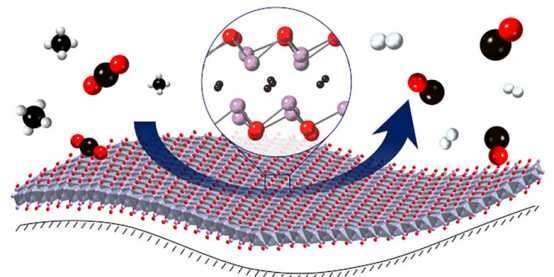Catalyst for sustainable gas synthesis

ETH researchers have developed a catalyst that converts CO2 and methane efficiently into synthesis gas—a mixture of hydrogen and carbon monoxide. This could potentially help to produce sustainable fuels and plastics
Today, almost all fuels, combustibles and plastics are based on fossil carbon sources, such as oil, natural gas and coal. The search is underway worldwide for ways to replace fossil hydrocarbons with sustainable alternatives. One approach is the synthesis of organic compounds from the climate damaging raw materials methane (CH4) and CO2.
In an initial step, the two greenhouse gasses must react with each other through the input of energy. This results in a gaseous mixture of energy-rich hydrogen (H2) and carbon monoxide (CO), known as synthesis gas.
A research team led by ETH professor Christoph Müller and senior scientist Alexey Fedorov has now developed an innovative catalyst that facilitates the conversion of CO2 and CH4 into synthesis gas much more efficiently than previous catalyst materials.
Synthesis gas is an important source material for the chemical industry. It can be further processed into synthetic liquid fuel or into methanol, which in turn serves as a base chemical in the manufacture of plastics.
Highly active and stable
The new catalyst consists of extremely thin metal oxycarbides—or more precisely the finest film of metal oxycarbides, just a few atomic layers thick, stabilized on an oxide support. The chemical reaction between CO2 and methane to form synthesis gas takes place on these thin layers.
These planar metal oxycarbides are around 1,000 times more active as a catalyst than their predecessors, metal carbides with a three-dimensional structure ("bulk" carbides). In addition, the new catalysts are extremely stable.
"Conventional catalysts based on metal carbides have the disadvantage that they oxidize in the presence of CO2, and lose their activity as a result," explains Müller, Professor of Energy Science and Engineering in the Department of Mechanical and Process Engineering. The new metal oxycarbides do not have this disadvantage.
Closing the carbon cycle
The catalytic reaction between CO2 and methane to produce synthesis gas is an important step towards the production of sustainable fuels and basic chemicals. Since CO2 can be sourced from the atmosphere and only methane comes from fossil resources millions of years old, such synthetic fuels and chemicals can have a lower carbon footprint than fossil fuels.
There is still a long way to go, before the results apply at industrial scale. "We hope that our new catalyst will become an attractive option for the production of synthesis gas," says Fedorov, research associate in Müller's group and co-author of the study.
According to the researchers, the new reaction catalyst could be used in particular to replace expensive precious metal catalysts, such as those based on ruthenium. However, due to their catalytic properties, atomically thin films of metal oxycarbides also have the potential to open up a wide range of new applications.
More information: Alexey Kurlov et al. Exploiting two-dimensional morphology of molybdenum oxycarbide to enable efficient catalytic dry reforming of methane, Nature Communications (2020). DOI: 10.1038/s41467-020-18721-0
Journal information: Nature Communications
Provided by ETH Zurich




















